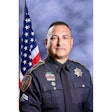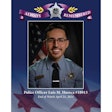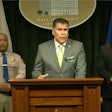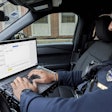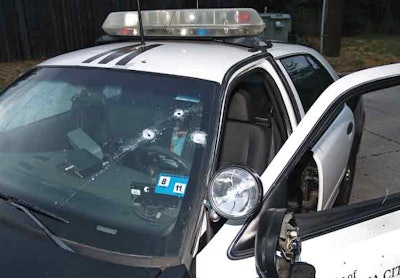 Officer Lawson's patrol car was hit numerous times; six rounds struck the officer. Photo courtesy of Oklahoma City Police Department.
Officer Lawson's patrol car was hit numerous times; six rounds struck the officer. Photo courtesy of Oklahoma City Police Department.
"Routine." If the maxim that there was no such thing as a routine traffic stop was true, it was similarly valid that there was no such thing as a routine backup request to one, either.
Still, the backup request Oklahoma City police officer Katie Lawson responded to on the night of August 29, 2010, was about as quintessentially normal as any.
Upon her arrival at the intersection of 38th Street and Miller Avenue, she found the requesting officer, an Oklahoma County Sheriff's deputy, standing outside his vehicle and giving frustrated commands to a driver that he'd stopped for a possible DUI. The driver had driven a mile or so before finally yielding near a residence where he'd parked his red Honda Civic. Such had been the scene since the backup request had been made. Such did it remain.
Lawson parked and exited her unit and took a position at the passenger side of the deputy's vehicle with her gun drawn and pointed at the car. Again the officer made verbal commands for the man to step from the car. Still no response.
As the deputy continued to issue commands to the unresponsive driver, two teenagers and a woman exited the residence and approached the middle of the front yard. Maintaining a respectful distance, the elder teen began speaking with the driver in Spanish, telling the man to get out of the car and do what the officers asked. Finally, the man got out of the car and lay down in the grass.
The deputy confirmed the man's intoxication and placed him under arrest. Lawson provided assistance and obtained information about the driver from the assisting parties.
Hector Mercado was the father of the two boys, ages 16 and 18, and husband to the woman. Since the parents spoke little or no English, the boys politely provided the officers with the man's date of birth.
Expressing their appreciation for the family's assistance, the officers ran the name through their respective department databases. The deputy was unable to find anything on Mr. Mercado; Lawson found that while the man had no warrants he had been previously arrested for DUI. As the two boys retreated back into their house, all that remained was to impound the car and book the driver.
Lawson pulled away from the scene and her mind began to contemplate what lay ahead for her—her need to document the stop for her log, followed by idle speculation as to what lay in store for the rest of her shift.
As Lawson cruised up Miller Avenue and near the parking lot adjacent to the rear of the Mercado house, she glanced out her driver's side window toward the back of the Mercado residence. That was when she noticed a male dressed in dark clothing standing with his back toward her.
Whatever illumination there was at this hour of the evening was owed to the street lights, which cast more shadows than light. As she tried to discern the man's face, he looked over his shoulder toward her. At the sight of her patrol unit he visibly flinched. Deciding to investigate further, Lawson angled her car into the driveway, put the car into park, and prepared to get out.
Is This Really Happening?
Before Lawson had time to open her car door, the man turned and raised a rifle and began shooting.
Lawson's mind kicked into a hyperkinetic drive, her synapses firing in rapid-fire succession of one another and keeping pace with the man's action on the trigger of the AR-15 he was wielding.
Is this really happening? she thought. Those rounds are coming right through my open window. I had better get out my gun and return fire.
 Aerial photo of the crime scene. Photo courtesy of Oklahoma City Police Department.
Aerial photo of the crime scene. Photo courtesy of Oklahoma City Police Department.
Bullets peppered her unit. And Lawson's mind quickly bridged the span from cognitive denial to decisive action, a transition that felt far longer than the milliseconds involved. By the time she leaned across her armrest and pulled out her gun, the shooter had started to advance, closing the distance between them to just 20 feet.
A bubble had descended over Lawson, muting the sound of gunfire after the initial volley. But the amber flashes of the AR-15 splitting the night were like beacons and she fixated on them as she leveled her Glock atop the bottom edge of her driver's window and returned fire.
At the sight of incoming rounds her assailant realized something: The cop was shooting back. Experiencing a change of heart, he turned tail and sprinted into the Mercados' backyard, where he disappeared from sight.
Less than a minute had passed since the suspect had first advanced on Lawson. Committed to giving chase to the suspect, she quickly advised dispatch that she'd been shot and the location where the suspect was last seen before throwing her door open and rushing out.
Lawson's feet felt like bricks. That she'd been shot at least once in her left buttock was painfully evident—her sciatic nerve was telling her as much. But just how many other rounds had found her was beyond her comprehension and she could find neither comfort nor fear in the absence of pain elsewhere in her body.
As she contemplated the tingling sensation in her leg Lawson became acutely aware of the silence. No radio traffic. No sirens. Surely with this type of serious situation, there would be an immediate response. Keying up her mic, she re-advised of her predicament and the last sighting of the suspect.
Timely Assistance
Officer C.J. Mustari had been in the area when he heard what he thought was fireworks and decided to investigate. As the first to arrive on scene, he found Lawson wounded in the street by her car. He helped her walk to the grass line at the side of the street.
Laying Lawson down near the curb, Mustari started to check her for injuries. By now more officers were converging upon the scene, some taking positions of cover while providing same while others gravitated to their wounded peer and began applying pressure to Lawson's wounds.
"Ouch," Lawson protested. "That hurts."
"Sorry," replied a voice. "I'm trying to stop the bleeding."
"Oh." Lawson closed her eyes.
Already search teams were deploying throughout the area of Northwest 38th Street. Some took notice of the two young men and their mother who appeared in the front yard of the Mercado house, acting as if they didn't know what had just happened in the parking lot behind their home. The officers also noticed the front door of the house was open and so went inside to clear it. They made their way through the kitchen and noticed a high-capacity rifle magazine lying atop the kitchen table. Realizing the shooting suspect might still be inside, they cleared the house, found no one, and awaited a search warrant.
When investigators were finally able to search the house, they found an AR-15 hidden under a floorboard in a bedroom, a shotgun in the attic, and a handgun secreted beneath a sofa cushion.
In the meantime Lawson had been transported to a local hospital where the extent of her injuries became known to her: She'd been hit six times. Fortunately, her car door had slowed two of the rounds enough to allow her ballistic vest to prevent penetration into the center of her rib cage and her back. A third round buried itself in her right calf, while two more struck her left butt cheek. The closest call came in the form of a round that had grazed her right cheek and pierced her right ear.
It would take much longer for Lawson to find out who had shot her.
Or why.
Sorting It All Out
During their investigation, detectives were advised by the Mercados' neighbors that at the time of Hector Mercado's arrest they'd heard his sons commiserating over their father's fate.
"We have to get him out," they'd heard one of the boys say in Spanish. From the other: "How are we going to get him out?"
The boys had reason to worry. Knowing that their father was, as an illegal immigrant, likely be deported as a result of his arrest, the teenagers devised a dangerous plan to free him. The oldest son, Hector Escalante, retreated into the house where he armed himself with an AR-15. His ill-formulated game plan was to sneak out the back door then double around to the front of the house to free his dad at gunpoint.
 Investigators found an AR-15 hidden under a floorboard in the bedroom of the Mercado home. Photo courtesy of Oklahoma City Police Department.
Investigators found an AR-15 hidden under a floorboard in the bedroom of the Mercado home. Photo courtesy of Oklahoma City Police Department.
Shortly after he'd exited the rear door he was surprised by Officer Lawson's unexpected presence in the parking lot. In a panic-induced Plan B, he let loose 26 rounds from his AR-15 while aggressing rapidly on the patrol car. Within a minute, all but three of those rounds had penetrated the car before Lawson returned fire.
Lawson was able to fire 11 rounds back at her assailant before he disappeared into the backyard of the Mercado property. Escalante ran to a bedroom inside the house, moved aside a bed, pulled back a rug, and hid the gun underneath a floor board. Changing his shirt, he then walked back out into the front yard as if nothing had happened. By then, Lawson lay bleeding on the grass by the roadway and the sounds of sirens filled the air.
During the trial, the older brother took full responsibility for the shooting and was sentenced to life plus 10 years in prison. The younger brother was found guilty, but sentenced to only three years. The mother, Velma Escalante, was found not guilty. In return for his DUI conviction, Hector Mercado received a stint in federal prison and was subsequently deported.
For her part in this "routine" backup request, Lawson spent four months recuperating from her injuries. After two additional months on light duty, she returned to patrol. She still suffers from some loss of sensation on the back of her left leg. While she is no longer in pain, the left side of her body tends to get tired more easily.
When asked to look back at the incident, Lawson doesn't think there was anything else she could have done to prepare for this ambush-like attack. From the moment she pulled into the driveway until the incident was over, she considered herself to be in the kill zone.
"I'd put the car in park and was in the process of getting out when he opened fire," she notes. "There simply wasn't time to commit my attention to getting the car back in drive and maneuvering it out of there. I had to engage."
That engagement and the will to survive are what ultimately saved her life, and possibly others. By not giving up and taking the fight to her attacker, Lawson put a decisive end to his murderous assault.
Tactically, she wishes that she'd had the presence of mind to conduct a tactical reload, as she'd been left with only two rounds with which to defend herself in the event her attacker doubled back to the scene. She does wonder to what extent things might have been mitigated had a Spanish-speaking officer been on scene.
Lawson has received numerous awards for her bravery. Both the Oklahoma City Police Department and the State of Oklahoma Chiefs of Police Association bestowed a Purple Heart and Medal of Honor on her. She traveled to Washington, D.C., to receive the Top Cop and Citizens Choice awards. She has also collected a variety of other awards from different organizations. She appreciates the numerous awards and acknowledges the debts owed to her training and the heroic actions of her fellow officers that night.
"Most of all I am thankful for God's glory," Lawson says. "He saved my life that night. And for that I am forever thankful."
After working patrol for one year following her return to duty, Lawson moved on to the city's Impact Team and currently conducts undercover plainclothes operations.










